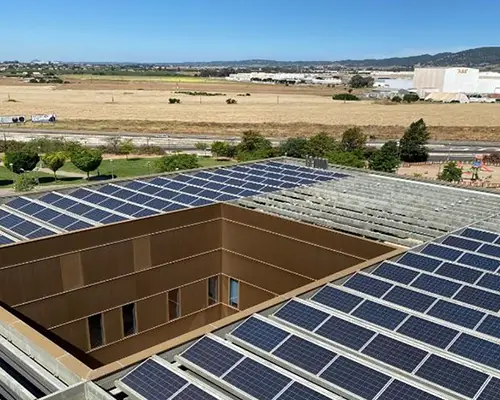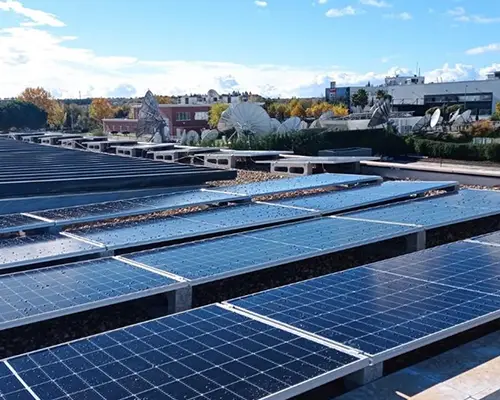Fighting climate change
Climate change and its effects are impacting Quirónsalud. In our healthcare facilities, we need to prepare for rising temperatures and the increase in severe weather events in order to continue to protect the health of patients in the best way possible.
The healthcare sector is responsible for approximately 4.4% of net global greenhouse gas (GHG) emissions, equivalent to the annual emissions of 514 coal-fired power plants, thus contributing to climate change.1
Climate change represents the greatest health hazard of the 21st century. In addition to affecting the quality of the air we breathe, it also affects the quantity and quality of fresh water and food. The increased incidence of extreme weather conditions also affects health, especially that of children growing up in unhealthier environments with higher temperatures that favor the spread of diseases such as malaria and dengue fever.
Consequently, given the fundamental role of health, both as an active and passive subject of climate change, and its responsibility for emissions and people’s health, the health sector must set an example and a benchmark in the decarbonization process. This will benefit society, the environment, and, therefore, health, especially that of the most vulnerable.
Therefore, in our commitment against air pollution and climate change at Quirónsalud, we strive to progressively reduce our GHG emissions, identifying areas and methods for transformational change. In this regard, our actions to achieve our GHG emissions reduction targets are in line with Fresenius’ climate objectives (have a look at the Group report for more details), and with the UN Sustainable Development Goals (SDGs).
GHG emissions reduction targets:
- 50% reduction of Scope 1 and Scope 2 GHG emissions by 2030 (base year: 2020)
- Climate neutrality (Scope 1 and Scope 2) by 2040
Mitigating climate change: MAS+
Given the impact of climate change, collaboration with other institutions can be crucial to mitigate its effects and raise awareness of its consequences. It has become clear over time that climate change has a direct impact on the health of the population and that the number of patients with diseases resulting from climate change is increasing – patients with respiratory diseases, for example.
With this in mind, the MAS+ project was launched at our Fundación Jiménez Díaz Hospital (FJD), which is leading in the development of innovative solutions in the healthcare sector. With this ambitious project, the FJD seeks to proactively launch initiatives and projects that reduce negative impacts on the environment and therefore on health. Examples of such projects are:
- Digitalization and technological enhancements: implementing innovative solutions such as telecare or print reduction initiatives
- Pharmaceutical and inhaler recycling processes and training programs
- Establishment of an efficient, sustainable energy supply
- Anesthetic gas best practices and cleaner substitutes
- Research and digitalization training programs
FJD Hospital’s revolutionary initiatives constitute an example to others. These actions have a direct impact on carbon footprint reduction and climate change, which in turn influence the population’s health (prevention and cure).
INSIGHTS INTO MAS+
Our use of energy
In order to reduce our carbon footprint, we are increasingly trying to use renewable energies. At the same time, as a hospital operator, it is extremely important that we always have enough energy to maintain operations and provide the best possible care to our patients.
Increase in energy efficiency
In order to reduce emissions sustainably, it is crucial that we have a good data basis to derive potential improvements. To achieve this, we have launched the Operational Digitalization and Monitoring of Buildings (DOME) project. You can find further information here.
The air conditioning systems in our hospitals stand for a large proportion of the total energy consumption of Quirónsalud. Since 2011, we have been working on automating the management of these devices and have integrated them all into the DOME system. For example, when outside temperatures drop, the systems adjust their output automatically. This allows us to better adapt to increasingly frequent, abrupt, and extreme temperature changes and save energy through more efficient use.
Improving air conditioning systems through the installation of reluctance motors and frequency converters, changing of burners, and replacement of diesel boilers with natural gas boilers, among others, as well as the substitution of conventional lighting with LEDs, has been key to ensuring more efficient energy use in our hospital and healthcare center operations.
As for hospital infrastructure, both the construction of new hospitals and the execution of new projects and refurbishments are designed and executed taking into account energy-efficiency improvement in use. To this end, a corporate report has been drawn up on the operation of the control systems of the centers and energy consumption, with the use of energy-efficient equipment, control and management systems, LED lighting, solar collectors, photovoltaic panels, and other energy-efficient systems, such as geothermal energy (the latter whenever possible).
Expansion of renewable energies
Since 2022, we have been incorporating solar panels for electricity generation in our hospitals as part of our efforts to reduce our climate impact and ensure the sustainability of our energy supply. The project began with a comprehensive analysis of the possibilities, prioritizing centers with sufficient space and owned properties.
Our photovoltaic systems in numbers
By the end of 2023, we had 10,563 panels in 19 centers, generating 5.6 GWh, which amounts to 6% of the total electricity consumed in these centers.
This achievement translates into a significant reduction of 1,422 tons of CO2e of our carbon footprint.


Carbon footprint
As the healthcare sector is responsible for a considerable percentage of the total GHG emissions, it is our responsibility to define and implement measures to reduce our carbon footprint and its impact on the environment and people’s health.
In collaboration with ECODES (an entity recommended by the Ministry of Health of the Government of Spain for the calculation of the carbon footprint in healthcare centers), we have been calculating our carbon footprint since 2016, following the GHG Protocol methodology, which distinguishes between three scopes:
Scope 1
Includes direct greenhouse gas emissions, i.e., those from emission sources owned or controlled by the organization.
Scope 2
Indirect emissions generated by the production of energy purchased by the organization.
Scope 3
Includes indirect emissions that are not included in Scope 2 and are generated along the entire value chain.
The results of our Scope 1 and 2 emissions can be seen in the following graph, which also includes the previous year’s emissions for ease of comparison.
Quirónsalud´s Scope 1 and Scope 2 emissions
Scope 1 includes fuel consumption in buildings, fuel consumption in the organization’s own vehicles, refrigerant gas leaks in air conditioning/cooling equipment, consumption of fire extinguishing gases, and consumption of anesthetic gases and inhalers. Scope 2 includes our electricity consumption, calculated according to the market approach, although the location approach is also available.
The 4% increase in our emissions is mainly attributable to an increase in Scope 1 emissions, driven by higher natural gas consumption due to the addition of new facilities and an increase in our activity. In addition, new sources of Scope 1 emissions have been identified, such as fire gases, other anesthetic gases not covered in the previous year, and inhalers.
1 The calculation is based on the Health Care´s Climate Footprint by the NGO Health Care Without Harm.


